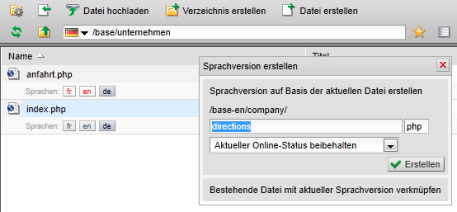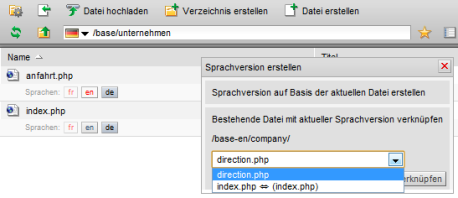Extended Language Management
With Weblication® CMS, you manage websites in as many languages as you want. Each language can dispose of differently named pages and directories within the same structure depth.
For a multilingual website, the different languages (e.g. German, English, French) can be organised by means of the module "Extended Language Management". Various functions and settings facilitate the editing process for the different languages and in some areas an automatism can be defined.
The extended language management allows for a free designation of the file and directory structure within the same structure depth based on the respective language directory. The connection of affiliated pages can be comfortably performed through the File explorer.
Example:
- /de/unternehmen/anfahrt.php
- /en/company/directions.php
- /fr/entreprise/lesdirections.php
Edit language connections
Corresponding pages are automatically recognised by the language management and automatically connected. If you want to have individual directory and/or file names in the respective language versions, you can determine them through the language connection in the Directory view. Please note the remarks regarding default language at the bottom!
Based on the (standard) language you can create non-existing language versions through an editing mask. The Directory view shows you the language abbreviation for all files and directories for each existing language as a button. For not yet existing pages in other language versions the language abbreviation is shown in red. The language version of the current directory is marked by a button in darker grey (in the exemplary screen shown below the language "de").
To create page in a different language based on the current language version, click on the red language abbreviation with the corresponding language.
The example gives an illustration by reference to the file /base/unternehmen/anfahrt.php demonstriert. When clicking the on the red language abbreviation "en" (button), the mask for "Create language version" will open:

To create a language version based on the current file, take the first selection. A mask will open for entering the file name. Enter the desired file name here (e.g. direction). The file extensions is already predefined based on the original language.

To connect an existing file with the current language, take the second selection. A mask will open for selecting the language connection. Select the desired file from the selection box of the already connected language directory and thereafter click on the button "Connect".

Undo language connections
To undo an existing language connection, call the directory of the corresponding file and click on the language abbreviation of the current language.
The example shows how you release the file /base-en/company/direction.php from the connection by clicking on the language abbreviation "en" in the directory /base-en/company/ for the file direction.php. In the selection box then click on the button "![]() Release current language version from the language connection", to delete it.
Release current language version from the language connection", to delete it.

Please note
You can also create new directories in a different language in the same way you did that for files. The only differences in the mask are the designation (e.g. "Create language version based on the current directory") and the input box for entering the directory name. In addition, when creating directories you may choose if you want to create it with contents or as an empty directory.
If an allocated language directory in the different language has not been created yet, no language files can be connected!
For multilingual websites, please define a default language, from which the language connections must be executed! This means that language connections can only be defined and solved via the defined language, thus ensuring a consistent language node management!


